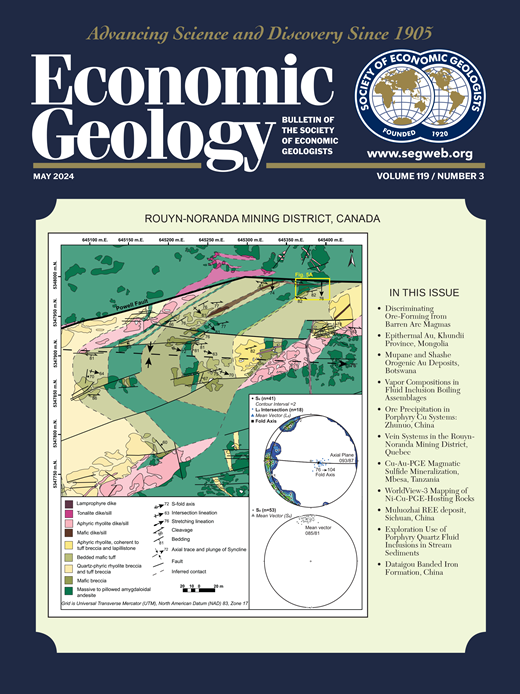卢旺达Musha-Ntunga地区辉石伟晶岩的岩浆、岩浆-热液及变形矿物演化
IF 4.9
1区 地球科学
Q1 GEOCHEMISTRY & GEOPHYSICS
引用次数: 0
摘要
中非中元古代Karagwe-Ankole带的伟晶岩与大型花岗岩杂岩有关,其侵位在1ga左右。本研究分析了东卢旺达Musha-Ntunga地区新鲜钠长辉石伟晶岩的岩心样品,在空间上与Muhazi湖花岗质岩体有关。结合岩石学、阴极发光显微镜、拉曼光谱、元素地球化学等方法,研究了岩浆期、岩浆-热液期、热液期及变形过程中的共生序列、微结构变化和锂分布。锂辉石分为五种结构类型。粗粒型1和辛粒型2形成于原生岩浆结晶过程,而粗粒型3和辛粒型4形成于岩浆-热液蚀变过程。局部变形影响伟晶岩侵入。锂辉石1型晶体呈脆性和延展性变形,呈西格玛碎屑状的斑岩碎屑(“锂辉石鱼”)和边界结构。大应变型锂辉石晶体部分再结晶为细晶细长型晶体(5型),与云母、石英和磷灰石呈带状分布,确定了片理的主要取向。辉钼矿既与辉石形成晚原生岩浆相,又与辉石形成岩浆-热液蚀变和变形过程中再结晶的次级岩浆相。长绿石、嗜锂石和库克石出现在后期热液相,取代了原生锂组合。伴生相白云母、磷灰石、微斜长石、钠长石、石英和铌钽矿进一步表明了从岩浆到(岩浆-)热液和变形体系的转变。变质沉积岩中电气石中锂含量的升高表明,锂在伟晶岩侵位、结晶和蚀变过程中分散到寄主岩中。这种多方法方法的结果表明,不同代的含锂矿物和相关结构不仅记录了从岩浆到热液体系的完整转变,而且记录了与变形相关的过程,这些过程可能影响伟晶岩中金属的分布。本文章由计算机程序翻译,如有差异,请以英文原文为准。
Magmatic, Magmatic-Hydrothermal, and Deformational Mineral Evolution of Spodumene Pegmatites from the Musha-Ntunga Area (Rwanda)
Pegmatites in the Mesoproterozoic Karagwe-Ankole belt of Central Africa are associated with large granitic complexes that were emplaced around 1 Ga. This study analyzes drill core samples of fresh albite-spodumene pegmatites from the Musha-Ntunga area (East Rwanda), spatially associated with the Lake Muhazi granitic pluton. We combine petrographic and cathodoluminescence microscopy with Raman spectroscopy and elemental geochemistry to study the paragenetic sequence, microtextural variations, and lithium distribution, from the magmatic and magmatic-hydrothermal stages to the hydrothermal stage and during deformation processes. Five textural types of spodumene are distinguished. Coarse-grained spodumene type 1 and symplectitic type 2 are interpreted to have formed during primary magmatic crystallization, whereas spodumene types 3 and 4 formed during magmatic-hydrothermal alteration. Deformation locally affected the pegmatite intrusions. Spodumene type 1 crystals deformed in a brittle and ductile manner, displaying sigma-clast-shaped porphyroclasts (“spodumene fish”) and boudinage textures. The large strained spodumene crystals were also partially recrystallized to fine-grained elongated crystals (type 5), which occur in bands along with mica, quartz, and apatite and define the main orientation of foliation. Montebrasite occurs both as a late primary magmatic phase with spodumene and as a secondary phase that recrystallized during magmatic-hydrothermal alteration and deformation. Eucryptite, lithiophilite, and cookeite occur as late-stage hydrothermal phases, replacing primary lithium assemblages. Associated phases muscovite, apatite, microcline, albite, quartz, and columbite-tantalite further demonstrate the transition from a magmatic to a (magmatic-)hydrothermal and deformational regime. Elevated lithium contents in tourmaline within the metasedimentary host rock indicate dispersion of lithium into the host rock during pegmatite emplacement, subsequent crystallization, and alteration. The results of this multimethod approach demonstrate that different generations of lithium-bearing minerals and associated textures not only record the full transition from a magmatic to hydrothermal regime but also document deformation-related processes that can impact the distribution of metals within pegmatites.
求助全文
通过发布文献求助,成功后即可免费获取论文全文。
去求助
来源期刊

Economic Geology
地学-地球化学与地球物理
CiteScore
10.00
自引率
6.90%
发文量
120
审稿时长
6 months
期刊介绍:
The journal, now published semi-quarterly, was first published in 1905 by the Economic Geology Publishing Company (PUBCO), a not-for-profit company established for the purpose of publishing a periodical devoted to economic geology. On the founding of SEG in 1920, a cooperative arrangement between PUBCO and SEG made the journal the official organ of the Society, and PUBCO agreed to carry the Society''s name on the front cover under the heading "Bulletin of the Society of Economic Geologists". PUBCO and SEG continued to operate as cooperating but separate entities until 2001, when the Board of Directors of PUBCO and the Council of SEG, by unanimous consent, approved a formal agreement of merger. The former activities of the PUBCO Board of Directors are now carried out by a Publications Board, a new self-governing unit within SEG.
 求助内容:
求助内容: 应助结果提醒方式:
应助结果提醒方式:


